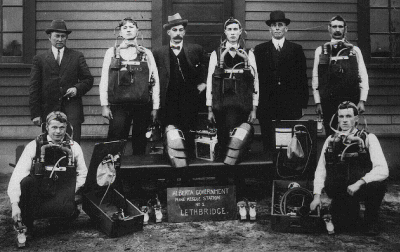
The danger from gas in Lethbridge coal mines was never very serious, but safety measures were still taken. The gas in coal mines is called methane (it is also known to miners as firedamp). It is a colourless, odourless, and highly flammable gas which can be explosive if mixed with air. The gas that was present in Lethbridge coal mines tended to come from cracks and crevices in the coal seam that were created when miners drove through the many faults present in the field. Mine managers commonly warned miners to guard against gas ignition when going through the faults or troubled ground. Their concern was that the gas emitted from a small jet could ignite and produce a flame five to eight centimeters long. Occasionally enough gas was present to trigger larger explosions, although they were usually of a localized nature. A dangerous situation that occurred quite commonly was the collection of gas in pockets near the mine ceiling. When workmen stood erect under the pocket, the open flame from the miners lamp would ignite a small explosion. By 1911 however, safety lights were used in the larger mines which lessened the danger to miners. An early method of detecting a build up of methane gas was through the use of canary birds. These birds were very responsive to the gas, and if miners saw a canary collapse they knew it was time to leave the mine. A metal and glass cage with an attached air tank was also kept near to make it possible to revive the little bird.

P19851028000-GM A mine rescue team poses for a picture while in full rescue gear.
Obviously, mine ventilation was of primary importance to worker safety. As the mines got bigger, very large quantities of air were required to properly ventilate the mine. Thus, large and costly centrifugal fans were situated at the entrances of the shafts. In 1928, it was reported that the largest of the fans in the Lethbridge district blew over 5600 cubic meters of air per minute through the mine. The cost of running those fans was considerable, but they were able to pump over 8100 tonnes of air through the mine every 24 hours. Ventilation not only provided men with fresh air, but it also diluted and vented the poisonous gas before it could become hazardous. A small explosion of methane gas, particularly in dry mines, caused coal dust to go into suspension and could set the stage for a far more serious explosion. Such explosions knocked out the ventilation systems and instantly used up two-thirds of the oxygen in the mine, replacing it with carbon dioxide. There were indications that this happened at Hillcrest, Alberta, when an explosion killed 189 men in 1919.
Previous Page | Exhibit Contents | Home | Navigation Information | Glossary | Curriculum Guide | Next Page
Copyright © 1996 Sir Alexander Galt Museum. All rights reserved.